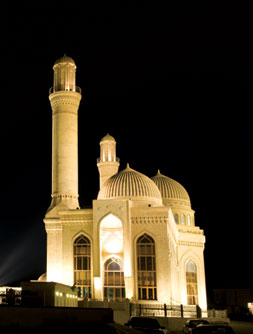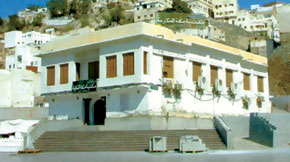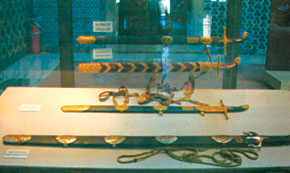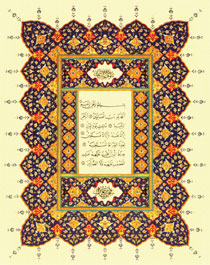Pages 62-66
by Abbas Gurbanov
Gurban Bayram, the Festival of Sacrifice or Eid al-Adha – considered the most sacred of holidays in the Islamic world - is celebrated in all Muslim countries. Sacrifice in various forms has existed in all celestial religions. However, in Islam this rite has a particular essence and significance. Endless love for Allah and a deep belief and faith in his power are the basis of this rite. The holiday is one of cleansing and purification for all.
People have celebrated Gurban Bayram here since the Islam religion was introduced to Azerbaijan. Since gaining independence and by the law “On holidays of the Republic of Azerbaijan” approved by the Milli Majlis (Parliament) on 27 October 1992, Gurban Bayram has been celebrated every year as a public holiday. This year it was celebrated from 14-17 November. We would like to offer more information about the spiritual life of Azerbaijan, the spread of Islam in the country and the achievements of Islamic civilization. This may contribute to intercultural and interreligious dialogue.
During the rule of Caliph Abu Bakr (10-12 AH/632-634 AD) the Islamic religion, with the caliphate’s army, moved beyond the borders of the Arabian Peninsula. However, there are some indications that this movement had begun even during the lifetime of the Prophet Muhammad (pbuh). After the battles of Muta in 7/629 and Tabuk in 8/630, the Prophet Muhammad (pbuh) had prepared an army under Usama’s command in 8-9/630-631 for dispatch to the city of Sham. Sometime later, the Arabian army went to Kadisiya, located between Azerbaijan and Iran and, after a victory at Nahavend, the army invaded Azerbaijani lands.
Muslims first made contact with Azerbaijan during Caliph Omar’s rule (12-22/634-644). The caliph’s first action after coming to power was to dispatch an army to Iraq under the command of Abu Ubeyd bin Masud es-Sagafi in 12-13/634-635. At that time disorder within the Sassanid government and rule by the underage Yazdigird III increased the chances of a Muslim victory. Caliph Omar ordered sahabas (people who had attended homilies of the prophet), Bukeyr b. Abdullah el-Leys and Utba b. Farhad es-Sulemiya to conquer Azerbaijan. Bukeyr b. Abdullah fought Isfendiyar b. Farruhdad, the brother of the Sassanid commander Rustam, on Mount Germidan and captured him during the battle. As Isfendiyar was not treated as a captive, he and all his attendants adopted Islam and became Muslims. Isfendiyar and Utba b. Farhad concluded an agreement in 17/639 in the following manner:
“In the name of God, Most Gracious, Most Merciful! This is confirm the guarantee of peace to the Azerbaijani population, to people living in the valleys, mountains and borders belonging to Utba b. Farhad, the tax collector of emir el-Muminin Omar ibn Khattab. People, their properties and estates, religions and rites are guaranteed peace in return for jizya (the head or poll tax that early Islamic rulers demanded from their non-Muslim subjects). Children, women, the sick and the poor, who have no property or income, and the clergy are exempted from the jizya. Every family is obliged to accommodate a soldier of the Muslim army and help him. A person wishing to be a soldier in the Muslim army will be exempted from tax for his year of service. People who decide to live in this country have equal rights. Those who desire to leave the country will have this guarantee until they find accommodation for themselves. This is written by Junadib and witnessed by Bukeyr b. Abdullah el-leys and Simak b. Harashi el-Ensari. Year of 18/639”
The exact dates of the first marches by the Muslim Arabian armies into Azerbaijan are not known. They are known to have occurred between 18-22/639-642-643. Incursions before this period had been sporadic and were for reconnaissance purposes. The Muslim Arabian armies launched sustained attacks against Azerbaijan after the battle of Nuhavend in 22/4-643. Sources vary greatly when dealing with this occupation of Azerbaijan.
In this period the Caucasian Albanian ruler, Javanshir sent a messenger to the Byzantine Emperor, Constanta II (20-47/641-668) and asked him to take them under his patronage as a precaution against future attacks by the Arabian army. The Emperor, who had dreamed of expansion, seized this opportunity. However, the political situation within the country did not stabilise. Khazar tribes attacked Albania from the north, plundered it and left it in ruins. The Byzantine Emperor gave no help in this situation, leaving Javanshir to solve the problems by himself.
Arabian invitation
Javanashir was frustrated with all these political games and his entrapment within the Byzantine, Sassanid and Khazar triangle; he began to establish relations with the stronger Arabian Caliphate for the long term. His people were also tired of the continuous battles and heavy taxes and supported Javanshir’s policy. In taking this step, Javanshir also avoided further attack from the Arabian armies.
According to the sources Javanshir met twice with the Arabian caliph, Muaviya. The first meeting was in 47/667 in Sham city and the second meeting took place in Damascus in 50/670. Caliph Muaviya met Javanshir in grand style and asked him to rule Atropatena as well. Javanashir did not agree because of the weight of taxes and asked the caliph to reduce them. The caliph implemented Javanshir’s request. Thus, Albania was adjoined to the Arabian caliphate but retained independence in its internal affairs. A conclusion from this is that, in giving his consent to Albanian independence, Caliph Muaviya recognised the great authority of Javanshir in the region. This situation also reveals that Arabian political control had not yet been completely established here, nor did Arabian armies have full dominion over Albania. This agreement was valid until 60/680, until, that is, Javanshir was assassinated.
During the first conquests by the Arabian armies, Caliph Abu Bakr established the properties and rules of behaviour for the armies of Islam. The Arabian armies which occupied Azerbaijan and Muslim deputies signed agreements with local governors in this context. According to these agreements, taxes were imposed on Muslims and non-Muslims as in any other part of the Muslim world. People were not forced to adopt the Islam religion and had the right to continue their current religion and customs.
Gradually Arabian armies located in Azerbaijan began to use both Muslims and non- Muslims as foot soldiers in the army. These forces did not receive salaries from the government. They only took shares in the loot seized during fighting and were exempted from taxes for the year of service. Local people familiar with the region played decisive roles during these struggles and were on the frontlines.
Settlement ....
Sources record no problems between Arabs and local population in the first years of the occupation of Azerbaijan by Arabian armies. This situation continued until the end of the rule of the Amavi Caliph Muaviya (Moauwiyeh). The problems occurred later, when the population was forced to adopt the Islam religion and because of the settlement policy, unfair tax laws and tyranny of Arabian governors who abused disorders at the centre. The Arab settlement policy was carried out in a more regulated manner than the migration policies enacted by other countries on Azerbaijani territory. Arab armies had to resettle Muslims into occupied territories. Actually, the spread of Islam and the popularisation of its culture were not conducted only by the occupation of territory. The life style, standards of behaviour and forms of prayer of Muslims could only be explained by living among the local people. In general, the adoption of the Islam religion by other nations occurred in this way.
Azerbaijan was one place where Arabs purposely settled a Muslim population. This settlement, however, was not practised with the aim of colonisation. On the contrary, Azerbaijani and Arab relations were so close that, as in the Ravvadis state, they were gradually considered to be inhabitants of this country. However, not all historians assess events in this way and do not see a difference between the settlement policy and one of colonisation. In the opinion of Bartold, the Islam religion, in contrast to Christianity, was not spread by individual missionaries. Thus Islam was spread by personal example and without the exertion of pressure on people of other religions.
Governor Ashas b. Gays, like the first governor of Azerbaijan, Huzeyfa b. el-Yeman, chose the city of Ardabil to be the centre of his settlement policy. The first group conveyed to Azerbaijan, mostly consisting of sahabas, was settled in Ardabil. Thus the city of Ardabil became the first homeland for Arab families entrusted with the task of attracting people to Islam. The more important and larger waves of resettlement took place during Hazrat Ali’s rule (35-40/656-661) when Ashas b. Gays was reassigned to Azerbaijan as a governor in 36/656-657. According to his words, by that time there were in Azerbaijan many people who had already adopted the Muslim religion and started to read the Koran.
Most Arabian tribes came from Yemen and consisted mainly of the Azd and Kinda tribes engaged in administration. For example, the first governor of Azerbaijan, Huzeyfa b. el-Yemen, belonged to the Azd tribe and Ashas (Eshas) b. Gays, who governed longer than others, belonged to the Kinda tribe. There is no precise information about the numbers of Arabians settled in Azerbaijan. Arabian settlements continued along the routes of conquests, in other words, from the south to the north. The Arabian armies particularly preferred central cities, regions of strategic significance and locations exposed to military threat. So the cities of Ardabil, Tabriz, Bazz, Beylagan, Shamakhi, Maragha, Barda and Derbend were cities with significant Muslim settlers.
In consequence of the settlement and accommodation of tribes here after the occupation of Azerbaijan by Arab armies, these lands underwent various changes. These changes were manifested not only in architecture, reconstruction and development but also in beliefs, ways of thinking, language and ethnology, due to people’s adoption of Islam. The human values carried with Islam in the early days created close relations between local people and the Arabs. There are villages and settlements in Azerbaijan today where many Arabic names and words are used.
...and example
The main duty of the Muslims resettled here was to gain people’s confidence by their exemplary conduct and behaviour and mild administration as compared with the Byzantium and Sassanid states. As life and property are highly valued by all, the security of life and property granted to people during the first conquests had a great influence on them. Local people had suffered from the battles between Byzantium and Persia and the destructive attacks of the Khazars and they were living in want. The population viewed the Arab armies as saviours. Prior to the rule of the Amavi Caliphate, the Arab administration had only collected taxes from the population; they had not interfered with their internal affairs. During the first decade after occupation, the population of Azerbaijan led a better and quieter life than in previous times.
There were several reasons why the Arab armies did not exert religious pressure from the start. Firstly, because the Arabs in the Arab armies which invaded Azerbaijan did not know the Islam religion well enough to propagate it. Secondly, most of the Azerbaijani population were possessors of the Bible; they were Christians. Notwithstanding all this, the Azerbaijani aristocracy adopted Islam earlier than the village populations. This is explained by the aristocracy’s strong desire to be closer to the caliphate’s administration.
The population located in Balasagun, in the Arran region, was the first to adopt Islam. Most of them, prior to adopting Islam, belonged to the religion of Majusi. It may be that either the Muslims worked harder on the followers of the Majusi religion (Zoroastrianism) or that the adherents to the latter religion considered the religious basis of the Islam to be superior and relevant to human nature. Thus, these people found spiritual comfort, not in the inherited religions, but in Islam.
Due to the tolerance and brotherhood cultivated by Islam they (local people and settled Muslims) were able to live together. Delivering freedom of religion, prayer, temples and life are the main terms of the expression “There is no compulsion in a religion”. The presence of sahabas and people close to the Prophet Muhammad (pbuh) was also very important. We can see it in the love and respect shown to them. Thus, people who had not forgotten the oppression and pursuits of Byzantium and Sassanid rulers adopted the religion of mercy and justice brought by the Muslims.
About the author: Abbas Gurbanov is a Ph.D in theology. He is the author of two books and several articles devoted to the history of the Islam religion, its spread in Azerbaijan and other subjects.
by Abbas Gurbanov
Gurban Bayram, the Festival of Sacrifice or Eid al-Adha – considered the most sacred of holidays in the Islamic world - is celebrated in all Muslim countries. Sacrifice in various forms has existed in all celestial religions. However, in Islam this rite has a particular essence and significance. Endless love for Allah and a deep belief and faith in his power are the basis of this rite. The holiday is one of cleansing and purification for all.
People have celebrated Gurban Bayram here since the Islam religion was introduced to Azerbaijan. Since gaining independence and by the law “On holidays of the Republic of Azerbaijan” approved by the Milli Majlis (Parliament) on 27 October 1992, Gurban Bayram has been celebrated every year as a public holiday. This year it was celebrated from 14-17 November. We would like to offer more information about the spiritual life of Azerbaijan, the spread of Islam in the country and the achievements of Islamic civilization. This may contribute to intercultural and interreligious dialogue.
During the rule of Caliph Abu Bakr (10-12 AH/632-634 AD) the Islamic religion, with the caliphate’s army, moved beyond the borders of the Arabian Peninsula. However, there are some indications that this movement had begun even during the lifetime of the Prophet Muhammad (pbuh). After the battles of Muta in 7/629 and Tabuk in 8/630, the Prophet Muhammad (pbuh) had prepared an army under Usama’s command in 8-9/630-631 for dispatch to the city of Sham. Sometime later, the Arabian army went to Kadisiya, located between Azerbaijan and Iran and, after a victory at Nahavend, the army invaded Azerbaijani lands.
Muslims first made contact with Azerbaijan during Caliph Omar’s rule (12-22/634-644). The caliph’s first action after coming to power was to dispatch an army to Iraq under the command of Abu Ubeyd bin Masud es-Sagafi in 12-13/634-635. At that time disorder within the Sassanid government and rule by the underage Yazdigird III increased the chances of a Muslim victory. Caliph Omar ordered sahabas (people who had attended homilies of the prophet), Bukeyr b. Abdullah el-Leys and Utba b. Farhad es-Sulemiya to conquer Azerbaijan. Bukeyr b. Abdullah fought Isfendiyar b. Farruhdad, the brother of the Sassanid commander Rustam, on Mount Germidan and captured him during the battle. As Isfendiyar was not treated as a captive, he and all his attendants adopted Islam and became Muslims. Isfendiyar and Utba b. Farhad concluded an agreement in 17/639 in the following manner:
“In the name of God, Most Gracious, Most Merciful! This is confirm the guarantee of peace to the Azerbaijani population, to people living in the valleys, mountains and borders belonging to Utba b. Farhad, the tax collector of emir el-Muminin Omar ibn Khattab. People, their properties and estates, religions and rites are guaranteed peace in return for jizya (the head or poll tax that early Islamic rulers demanded from their non-Muslim subjects). Children, women, the sick and the poor, who have no property or income, and the clergy are exempted from the jizya. Every family is obliged to accommodate a soldier of the Muslim army and help him. A person wishing to be a soldier in the Muslim army will be exempted from tax for his year of service. People who decide to live in this country have equal rights. Those who desire to leave the country will have this guarantee until they find accommodation for themselves. This is written by Junadib and witnessed by Bukeyr b. Abdullah el-leys and Simak b. Harashi el-Ensari. Year of 18/639”
The exact dates of the first marches by the Muslim Arabian armies into Azerbaijan are not known. They are known to have occurred between 18-22/639-642-643. Incursions before this period had been sporadic and were for reconnaissance purposes. The Muslim Arabian armies launched sustained attacks against Azerbaijan after the battle of Nuhavend in 22/4-643. Sources vary greatly when dealing with this occupation of Azerbaijan.
In this period the Caucasian Albanian ruler, Javanshir sent a messenger to the Byzantine Emperor, Constanta II (20-47/641-668) and asked him to take them under his patronage as a precaution against future attacks by the Arabian army. The Emperor, who had dreamed of expansion, seized this opportunity. However, the political situation within the country did not stabilise. Khazar tribes attacked Albania from the north, plundered it and left it in ruins. The Byzantine Emperor gave no help in this situation, leaving Javanshir to solve the problems by himself.
Arabian invitation
Javanashir was frustrated with all these political games and his entrapment within the Byzantine, Sassanid and Khazar triangle; he began to establish relations with the stronger Arabian Caliphate for the long term. His people were also tired of the continuous battles and heavy taxes and supported Javanshir’s policy. In taking this step, Javanshir also avoided further attack from the Arabian armies.
According to the sources Javanshir met twice with the Arabian caliph, Muaviya. The first meeting was in 47/667 in Sham city and the second meeting took place in Damascus in 50/670. Caliph Muaviya met Javanshir in grand style and asked him to rule Atropatena as well. Javanashir did not agree because of the weight of taxes and asked the caliph to reduce them. The caliph implemented Javanshir’s request. Thus, Albania was adjoined to the Arabian caliphate but retained independence in its internal affairs. A conclusion from this is that, in giving his consent to Albanian independence, Caliph Muaviya recognised the great authority of Javanshir in the region. This situation also reveals that Arabian political control had not yet been completely established here, nor did Arabian armies have full dominion over Albania. This agreement was valid until 60/680, until, that is, Javanshir was assassinated.
During the first conquests by the Arabian armies, Caliph Abu Bakr established the properties and rules of behaviour for the armies of Islam. The Arabian armies which occupied Azerbaijan and Muslim deputies signed agreements with local governors in this context. According to these agreements, taxes were imposed on Muslims and non-Muslims as in any other part of the Muslim world. People were not forced to adopt the Islam religion and had the right to continue their current religion and customs.
Gradually Arabian armies located in Azerbaijan began to use both Muslims and non- Muslims as foot soldiers in the army. These forces did not receive salaries from the government. They only took shares in the loot seized during fighting and were exempted from taxes for the year of service. Local people familiar with the region played decisive roles during these struggles and were on the frontlines.
Settlement ....
Sources record no problems between Arabs and local population in the first years of the occupation of Azerbaijan by Arabian armies. This situation continued until the end of the rule of the Amavi Caliph Muaviya (Moauwiyeh). The problems occurred later, when the population was forced to adopt the Islam religion and because of the settlement policy, unfair tax laws and tyranny of Arabian governors who abused disorders at the centre. The Arab settlement policy was carried out in a more regulated manner than the migration policies enacted by other countries on Azerbaijani territory. Arab armies had to resettle Muslims into occupied territories. Actually, the spread of Islam and the popularisation of its culture were not conducted only by the occupation of territory. The life style, standards of behaviour and forms of prayer of Muslims could only be explained by living among the local people. In general, the adoption of the Islam religion by other nations occurred in this way.
Azerbaijan was one place where Arabs purposely settled a Muslim population. This settlement, however, was not practised with the aim of colonisation. On the contrary, Azerbaijani and Arab relations were so close that, as in the Ravvadis state, they were gradually considered to be inhabitants of this country. However, not all historians assess events in this way and do not see a difference between the settlement policy and one of colonisation. In the opinion of Bartold, the Islam religion, in contrast to Christianity, was not spread by individual missionaries. Thus Islam was spread by personal example and without the exertion of pressure on people of other religions.
Governor Ashas b. Gays, like the first governor of Azerbaijan, Huzeyfa b. el-Yeman, chose the city of Ardabil to be the centre of his settlement policy. The first group conveyed to Azerbaijan, mostly consisting of sahabas, was settled in Ardabil. Thus the city of Ardabil became the first homeland for Arab families entrusted with the task of attracting people to Islam. The more important and larger waves of resettlement took place during Hazrat Ali’s rule (35-40/656-661) when Ashas b. Gays was reassigned to Azerbaijan as a governor in 36/656-657. According to his words, by that time there were in Azerbaijan many people who had already adopted the Muslim religion and started to read the Koran.
Most Arabian tribes came from Yemen and consisted mainly of the Azd and Kinda tribes engaged in administration. For example, the first governor of Azerbaijan, Huzeyfa b. el-Yemen, belonged to the Azd tribe and Ashas (Eshas) b. Gays, who governed longer than others, belonged to the Kinda tribe. There is no precise information about the numbers of Arabians settled in Azerbaijan. Arabian settlements continued along the routes of conquests, in other words, from the south to the north. The Arabian armies particularly preferred central cities, regions of strategic significance and locations exposed to military threat. So the cities of Ardabil, Tabriz, Bazz, Beylagan, Shamakhi, Maragha, Barda and Derbend were cities with significant Muslim settlers.
In consequence of the settlement and accommodation of tribes here after the occupation of Azerbaijan by Arab armies, these lands underwent various changes. These changes were manifested not only in architecture, reconstruction and development but also in beliefs, ways of thinking, language and ethnology, due to people’s adoption of Islam. The human values carried with Islam in the early days created close relations between local people and the Arabs. There are villages and settlements in Azerbaijan today where many Arabic names and words are used.
...and example
The main duty of the Muslims resettled here was to gain people’s confidence by their exemplary conduct and behaviour and mild administration as compared with the Byzantium and Sassanid states. As life and property are highly valued by all, the security of life and property granted to people during the first conquests had a great influence on them. Local people had suffered from the battles between Byzantium and Persia and the destructive attacks of the Khazars and they were living in want. The population viewed the Arab armies as saviours. Prior to the rule of the Amavi Caliphate, the Arab administration had only collected taxes from the population; they had not interfered with their internal affairs. During the first decade after occupation, the population of Azerbaijan led a better and quieter life than in previous times.
There were several reasons why the Arab armies did not exert religious pressure from the start. Firstly, because the Arabs in the Arab armies which invaded Azerbaijan did not know the Islam religion well enough to propagate it. Secondly, most of the Azerbaijani population were possessors of the Bible; they were Christians. Notwithstanding all this, the Azerbaijani aristocracy adopted Islam earlier than the village populations. This is explained by the aristocracy’s strong desire to be closer to the caliphate’s administration.
The population located in Balasagun, in the Arran region, was the first to adopt Islam. Most of them, prior to adopting Islam, belonged to the religion of Majusi. It may be that either the Muslims worked harder on the followers of the Majusi religion (Zoroastrianism) or that the adherents to the latter religion considered the religious basis of the Islam to be superior and relevant to human nature. Thus, these people found spiritual comfort, not in the inherited religions, but in Islam.
Due to the tolerance and brotherhood cultivated by Islam they (local people and settled Muslims) were able to live together. Delivering freedom of religion, prayer, temples and life are the main terms of the expression “There is no compulsion in a religion”. The presence of sahabas and people close to the Prophet Muhammad (pbuh) was also very important. We can see it in the love and respect shown to them. Thus, people who had not forgotten the oppression and pursuits of Byzantium and Sassanid rulers adopted the religion of mercy and justice brought by the Muslims.
About the author: Abbas Gurbanov is a Ph.D in theology. He is the author of two books and several articles devoted to the history of the Islam religion, its spread in Azerbaijan and other subjects.







